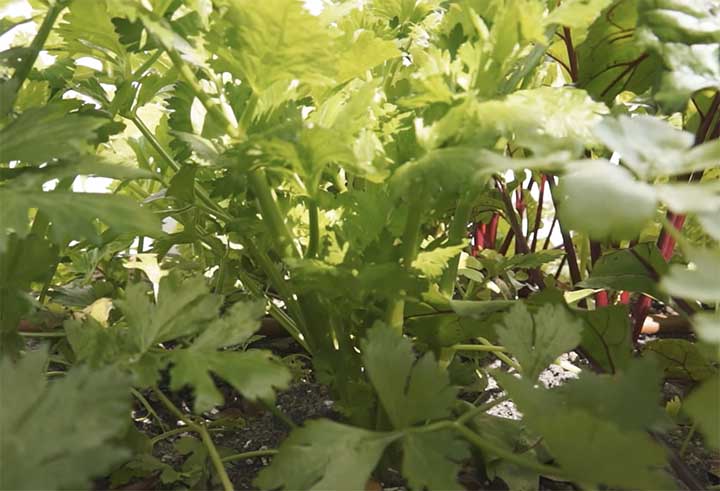If you’ve never had garden-grown celery, watch out! While celery sometimes gets a reputation for being flavorless and watery, fresh celery is packed with flavor, crunch, and nutrients!
This crop can be a bit challenging to grow due to its long time to maturity, need for lots of water, and susceptibility to pests. However, with the right information in hand, you can grow a successful celery crop at home.
Companion planting is one way to increase the chances you’ll end up with healthy celery plants. This practice involves grouping plants together to utilize the benefits they provide to each other.
Join us as we cover the benefits of using companion planting when growing celery and introduce you to some of the best and worst companion plants for celery.
The Benefits of Companion Planting When Growing Celery
As mentioned above, companion planting involves planting beneficial plants next to each other.
In some cases, celery plants will provide benefits to the other crop. And in other cases, celery will be the crop that benefits.
Here are some of the benefits you can expect when you utilize companion planting with celery.
Pest Control
Like most crops, celery is susceptible to attack from various pests. Preventing and controlling these pests is one key part of growing healthy celery.
Aphids are some of the most common celery pests. While a few of these tiny pests won’t cause much damage, larger populations can severely damage celery. This is especially true when we’re talking about younger plants.
Aphids have specialized mouthparts that they use to pierce plant leaves and suck plant sap. If enough aphids attack a celery plant, it can become weak, wilted, and stunted.
One of the hard parts about controlling aphids is that the pests rapidly multiply. When the weather is warm, adults can produce ten offspring each day!
That means that if you take your eyes off your celery plants for just a few days, you may come back to hundreds of aphids! One way to avoid this situation is by encouraging the presence of predatory insects.
The larval forms of insects like green lacewings, parasitic wasps, and ladybugs voraciously feed on aphids. Plus, they are able to scout out the pests and feed on them before their numbers get out of control.
One thing to note about these predators is that the adults often feed on other food sources. Many adult insects eat nectar and/or pollen rather than insects.
Therefore, planting flowering plants near your celery plants may help attract these predatory insects to your garden. If the adults have food to eat, they’re more likely to stick around and lay their eggs near pests like aphids.
Maximize Garden Space
Since celery takes around three months to mature, it will spend quite a bit of time in your garden. However, it will remain quite small for much of this time.
Rather than letting the empty ground around your little celery plants sit idle, you can plant quick-growing crops to fill in these bare spaces. By the time the celery and the quick-growing crop begin encroaching on each other, the smaller crop will be ready to harvest.
Not only will you be able to harvest a second crop, but the other crop can also help conserve soil moisture and shade out weeds.
This means that you may be able to get away with watering your celery plants less. Plus, you may also be able to spend less time weeding.
Provide Nutrients
Celery plants require lots of nutrients to thrive. Along with the macronutrients nitrogen, phosphorus, and potassium, this crop also requires a good amount of calcium as well as trace minerals.
Planting legumes like beans, peas, and clovers with or before celery can decrease the amount of nitrogen you’ll need to apply to the soil. These plants contain root nodules that host nitrogen-fixing bacteria known as rhizobia.
The bacteria take in nitrogen from the atmosphere and convert it into a plant-available form that the legumes can use. In return, the plants provide the bacteria with carbohydrates.
While the legumes take up some of the nitrogen the bacteria release, the rest of it enters the soil. At this point, nearby crops like celery can take up the excess nitrogen.
The Best Celery Companion Plants
Wondering what plants you should grow near your celery? Check out this list of some of the best companion plants.
1. Marigolds
As long as conditions are right, marigolds can produce flowers over the course of multiple months. Just don’t forget to remove dead flowers to encourage new ones to form!
These marigold flowers can help attract predatory insects like green lacewings, parasitic wasps, and ladybugs. When the adults of these beneficial insects are in your garden, they may choose to lay their eggs near celery pests. Once the eggs hatch, the larvae feed on pests like aphids.
Since marigold plants and celery can both get quite large, it’s important to use proper plant spacing. Planting the marigolds three feet away from celery will allow both plants to expand.
While some people say that marigolds’ fragrance can deter pretty much any pest, there isn’t a ton of research backing this up. Some reports show that marigolds can lower pest populations, but this may be due to the flower’s ability to attract predatory insects rather than their scent.
2. Lettuce
Celery plants require lots of nutrients to grow, which means you’ll sometimes hear them referred to as heavy feeders. They require large amounts of nitrogen, phosphorus, potassium, and calcium throughout their life.
However, nutrient needs peak during the last few weeks of the plant’s growth. That means that you will likely need to apply fertilizer while the celery is growing.
So, what does this have to do with lettuce? Lettuce plants are light feeders that don’t require tons of nutrients to thrive.
That means they will not rob the celery of important nutrients. However, lettuce plants also will remain healthy even if excess nutrients are present in the soil.
Since celery takes such a long time to mature (about 80 days from transplant to harvest), lettuce plants can help you maximize the empty ground that is present when the celery plants are young. Tucking some lettuce plants in the space between celery plants can help conserve moisture and also let you harvest two crops rather than one.
3. Calendula
Looking for another flowering plant that can help attract predatory insects that eat pests like aphids? Try out calendula!
This flowering plant produces oodles of colorful edible flowers that also have medicinal properties.
Since calendula likes cooler weather, it’s a great option to tuck in the garden in the early spring. If you plant these blooming beauties early enough, they might already be flowering when it comes time to transplant your celery.
Make sure to deadhead your calendula plants, aka remove the dead flowers, to encourage a continuous supply of healthy blooms.
4. Sweet Alyssum
This tiny plant produces hundreds if not thousands of tiny flowers. While the individual flowers may appear small, their size is perfect for beneficial insects like parasitic wasps, tachinid flies, and hoverflies.
When the adult forms of these insects come into the garden to feed on sweet alyssum, they’re more likely to lay their eggs near pesky aphids. These eggs then hatch and the larvae get into devouring the aphids.
That means that your celery plants can continue to grow without the harm of aphids.
5. Peas
Peas are a type of legume, which means they host nitrogen-fixing bacteria. By growing peas before or next to your celery, you’ll decrease the amount of nitrogen fertilizer you’ll need to provide your celery plants.
The tricky thing about growing peas and celery together is getting the timing right. Peas are cool-weather crops that can be planted in the early spring as soon as the ground has thawed.
Celery, on the other hand, likes to head out into the garden once the temperatures are warm and stable. That means you’ll want to plant your peas out in the garden first and then add the celery plants later on.
If you are growing peas on a trellis, you can tuck celery seedlings about eight inches away from the peas. By the time the celery plants have grown a bit, it will be time to cut the pea plants down.
Make sure to be careful while removing the pea plants so you don’t crush the celery plants or disturb their roots.
6. Arugula
If you’re looking for another quick-growing crop to tuck beside your slowly maturing celery, consider arugula. This peppery green is ready to harvest about three weeks after seeding, which makes it easy to sneak into empty spaces in the garden.
Planting a row of baby arugula beside a row of celery plants will allow you to harvest a second crop from the same area. By the time the celery begins to encroach on the arugula, you can cut or pull the arugula plants out of the ground.
Another option is to plant the arugula plants a bit further (about 18 inches) away from the celery plants. After you cut the arugula one or two times, you can let it go to flower.
The arugula flowers will then help attract beneficial insects like ladybugs, parasitic wasps, and green lacewings. Having these good bugs in your garden can help keep celery pests like aphids and armyworms in check.
Plants to Avoid Planting Next to Celery
Just like companion planting can benefit celery, planting the wrong plants next to celery can make it difficult to grow a healthy crop. If you have the space, avoid growing these plants beside celery.
1. Sage
Remember how we said that celery likes lots of water? Well, sage is quite the opposite.
If sage plants sit in wet soil, they will quickly become unhappy. However, they can tolerate brief periods of drought.
On the other hand, celery is not a fan of dry soil and will suffer during drought. Since these two plants require different moisture levels, it’s best to avoid planting them next to each other.
2. Zucchini
While celery and zucchini plants both mature during the warmer summer months, the two aren’t the best companions.
Celery is a relatively slow-growing crop that doesn’t compete well with other crops. And zucchini is a quick-growing crop that can quickly take over a large chunk of the garden.
If you plant zucchini within a few feet of your celery plants, the zucchini plants will likely overtake the celery plants.
3. Winter Squash
Winter squash is another plant that can overtake celery plants. Therefore, you should avoid planting winter squash within five or six feet of celery plants.
If you do plant trailing winter squash varieties like butternut or delicata near your celery plants, make sure to keep an eye on the squash vines. If they begin getting within a few feet of your celery plants, redirect them to grow away from the celery.






